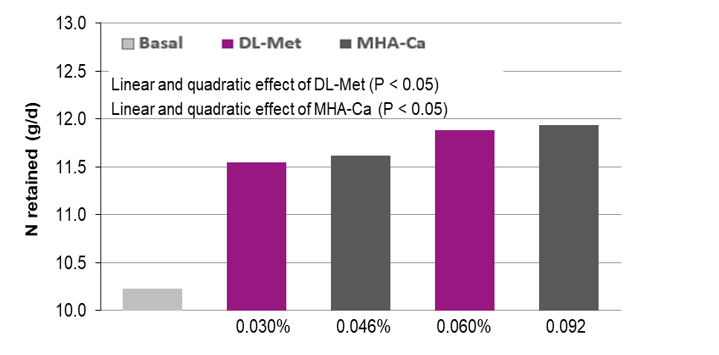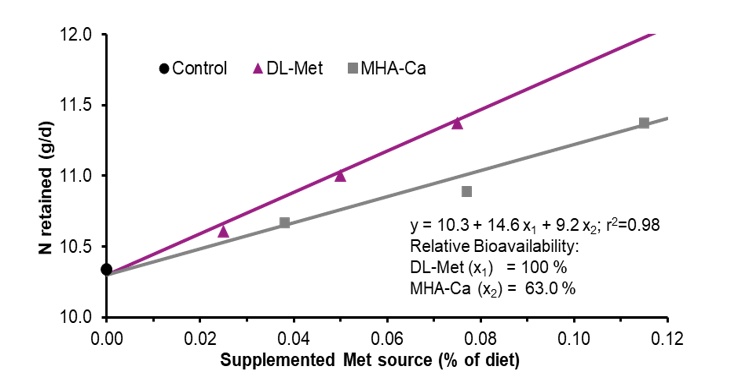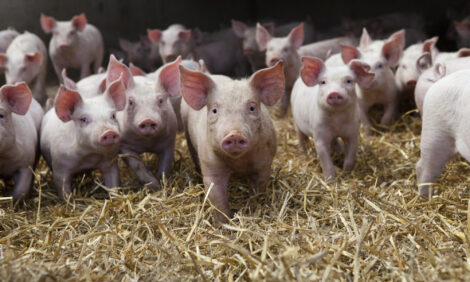



Studies show a lower bioavailability for alternative methionine source relative to DL-Methionine in starter pigs
Methionine (Met) – an essential amino acid in pig diets to optimize performance – has been available mainly in two forms, DL-Methionine (99%) and liquid DL-Methionine hydroxy analogue-free acid (MHA-FA, 88%) for many years. Some years ago, however, the calcium salt of hydroxy analog of DL-Methionine (MHA-Ca, 84%) was re-introduced to the market as an alternative Met source for poultry and swine. This re-introduction generated questions about MHA-Ca’s biological effectiveness or relative bioavailability (RBV) compared with DL-Methionine as a Met source.Most of the published studies dealing with the RBV of Met sources in pigs have focused on liquid MHA-FA. For example, Kim et al (2006) determined the RBV of liquid MHA-FA relative to DL-Methionine to be 66% on a product-to-product basis based on nitrogen (N) retention (g/d) in 17-21 kg pigs. Compared with growth trial, using N-balance procedure allows an accurate estimation of N retention (N intake – N excretion in urine and feces) of individual pigs. The measured N retention reflects body protein deposition rate of the pigs and can be used as the basis for RBV comparison.
Based on the N-balance parameters, Opapeju et al. (2012) reported that the average RBV of MHA-Ca to DL-Methionine to support N retention was 71% on a product-to-product basis in 19-23 kg starter pigs. Similarly, replacing 100 parts of MHA-Ca with 65 parts of DL-Methionine to supply Met in Met-deficient diets maintained similar performance of 12-20 kg pigs raised under commercial conditions in Spain, which confirms the RBV for MHA-Ca relative to DL-Methionine of 65% (Facts&Figures No. 1465).
Robust data needed for optimum performance
Reliable information about the RBV of Met sources is crucial to formulate diets that are cost effective whilst supporting maximum performance. However, information about the RBV of MHA-Ca to DL-Methionine in pigs is still less available compared with that of MHA-FA. Therefore, two experiments (exp) were conducted – one in Lexington, USA (collaboration with Prof. M. D. Lindemann, University of Kentucky) , and one in Ho Chi Minh City, Vietnam (collaboration with Dr. L. V. Kinh, Institute of Agricultural Sciences for Southern Vietnam) – to determine the RBV of MHA-Ca compared with DL-Methionine in starter pigs fed corn-soybean meal-based diets using N balance technique (Wang, et al., 2020).
General experimental procedure
In both exp. 1 and 2, after a 7-day (d) adaptation to the metabolism crate and experimental diets, feces and urine were collected quantitatively for 5 days. Pigs were weighed at the beginning and end of the adaptation period and at the end of collection. Daily feed allowance during the adaptation and collection periods was set at 3.5% of the average body weight (BW). The daily feed allotment was divided into 3 equal portions. Diets were in mash form and pigs had unlimited access to drinking water.
Experiment one: Lexington
A Met-deficient basal diet (0.22% total Met) was supplemented with 2 graded levels of DL-Met or MHA-Ca at DL-Met to MHA-Ca ratio of 65:100 on product-to-product basis to create 5 diets. A total of 40 barrows [Hampshire × (Landrace/Yorkshire); initial BW of 15.5 kg] were assigned to 7 dietary treatments in a completely randomized design with 6 replicate pens per treatment and 1 pig per pen, for 12-days. Supplementation of both Met sources did not affect fecal N output but urinary N (g/d) excretion linearly decreased (P < 0.001) with increasing levels of both Met sources, which resulted in a linear increase (P < 0.001) in retained N (g/d; Figure 1) for both DL-Methionine and MHA-Ca, indicating that the basal diet was clearly deficient in Met. Nitrogen retention (g/d) was not different when DL-Methionine and MHA-Ca were supplemented to the basal diet at a ratio of 65:100 for both supplemental levels. Furthermore, N retention rate (% of intake) linearly increased (P < 0.001) with increasing levels of both Met sources.

Due to the linear effect for N retention responses and having only two graded levels of Met addition, the RBV of MHA-Ca to DL-Methionine were determined according to a linear slope-ratio procedure as described by Littell et al. (1997): y = a + b1x1 + b2x2 (where b1 and b2 refer to the slope of DL-Methionine and MHA-Ca, and x1 and x2 refer to dietary level of DL-Methionine and MHA-Ca, respectively).

Using a linear slope-ratio procedure, the RBV of MHA-Ca compared to DL-Met was 68.4% on a product-to-product basis (Figure 2). Based on an MHA-Ca content of 84% in the commercial product, this equates to an RBV of MHA-Ca to DL-Met of 81.4 % on an equimolar basis.
Experiment two: Ho Chi Minh City
Similarly, a Met-deficient basal diet (0.22% total Met) was supplemented with 3 graded levels of DL-Met or MHA-Ca at DL-Met to MHA-Ca ratio of 65:100 on product-to-product basis to create 7 diets which were assigned to 42 barrows (Duroc × (Large white/Landrace); initial BW of 15.0 kg) for 12 days.
Graded supplementations of both Met sources to the basal diet decreased both the fecal N excretion (P < 0.01). Urinary N excretion was reduced (P = 0.001) by supplementation of the basal diet with DL-Methionine but was not affected by MHA-Ca addition. Methionine deficiency in the diet limits the use of other amino acids for protein synthesis, and thus would increase the amount of amino acids to be catabolized and excreted mainly as urea N via urine. Thus, a lower level of N excretion in the urine with DL-Methionine addition suggests a better utilization of DL-Methionine for N retention compared with MHA-Ca in Met-deficient diets.

Nitrogen retention expressed as g/d linearly increased (P < 0.01) with supplementations of the basal diet with DL-Methionine and MHA-Ca, however, there were not affected by Met sources in this experiment (Figure 3). These results also indicate that the N retention of pigs are similar when fed diets supplemented at DL-Methionine to MHA-Ca ratio of 65:100 on a product-to-product basis.

Using a linear slope-ratio procedure, the RBV of MHA-Ca compared to DL-Met was 63.0% on a product-to-product basis or 75.0% on equimolar basis based on N retained (g/d; Figure 4).
Conclusion
Based on the results from both experiments conducted at different locations, an average RBV of MHA-Ca to DL-Met of 65.7% on a product-to-product basis or 78.2% on an equimolar basis. This is in good agreement with the previously reported RBV values (for MHA-Ca and liquid MHA-FA in pigs. Overall, the current trial results also demonstrated that the 65 parts of DL-Methionine can replace 100 parts of MHA-Ca and achieve the same N retention of starter pigs.









